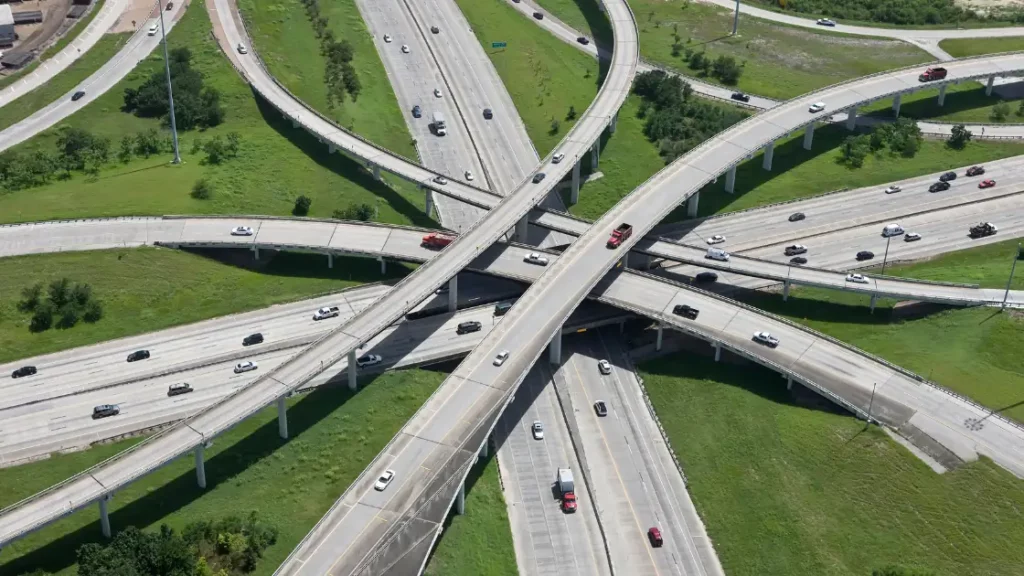This could be a headline on any day this week, month or even year. Although the exact number for this week alone isn’t known, there have been more than a dozen reported accidents leading to injury and, in some cases, death. As a Dallas and Fort Worth personal injury attorney and wrongful death attorney, we know these heartbreaking data because we’re working with clients every day involved in accidents on I-35.
Interstate 35 runs for more than 600 miles in Texas, from Laredo near Mexico’s border all the way northward to Gainesville along Red River and Gainesville’s Red River. Connecting San Antonio, Austin, Waco, Dallas/Fort Worth; it is one of Texas most heavily traveled roadways. According to the data published in 2021 by the Austin-based insurance marketplace The Zebra, I-35 is one of the ten deadliest roads in the United States, with 12.56 fatal collisions per 100 miles.
Why is I-35 One Of The Most Congested And Dangerous Highways In Texas?
Although statistics vary throughout the nation, the average cost of a vehicular accident where no one sustains major injury or dies is close to $9,000. However, accidents along interstates are much more likely to include major injury and death and can cost over a million dollars according to the National Safety Council. Sadly, 2021 is set to become one of the most hazardous years on Texas roads.
San Antonio’s I-35 highway can often be perceived as being dangerous due to various contributing factors that increase its risk of accidents, among them;
Heavy Traffic on I-35: During peak travel times, Interstate 35 experiences severe congestion and traffic volume issues that create hazardous road conditions, increasing the chances of accidents by forcing sudden stops, tailgating incidents, and rear end collisions.
Construction Zones: I-35 has long been plagued by frequent construction projects that pose hazards for drivers. Construction zones often feature reduced speed limits, lane closures and shifting traffic patterns which increase the risk of accidents should drivers fail to navigate with care through these areas.
Merge Points and Interchanges: I-35 contains multiple merge points, on-ramps, and interchanges where vehicles must merge or switch lanes, creating challenging navigation conditions during busy traffic peaks and increasing the potential risk of sideswipe accidents or collisions caused by improper merging practices.
Deceptively Difficult Road Conditions: Driving along I-35 may present drivers with challenging road conditions such as potholes, uneven surfaces and poor signage that make driving hazardous in adverse weather conditions.
Common Accidents On I-35
Rear-End Collisions: These accidents often result from tailgating, distracted driving or sudden brakes by one vehicle crashing into another’s rear end.
Pileup Accidents: Multi-vehicle pileup accidents arise when multiple vehicles collide due to limited visibility, poor weather conditions or sudden traffic congestion.
Side-Impact Collisions (T-bone Accidents): Side-impact crashes are commonly known as T-bone incidents; they happen when one vehicle strikes the side of another at an acute angle – typically occurring during intersections or lane changes.
Rollover Accidents: These collisions involve vehicles rolling onto their side or roof due to sharp turns, fast speeds, or loss of control of a vehicle.
Accidents Owing to Distracted Driving: These incidents include those caused by drivers becoming distracted from operating their vehicles by looking at phones, eating, talking with passengers or engaging in other activities while using them.
Head-On Collisions (HCCs): These collisions often happen between vehicles traveling in opposite directions and often result from driver fatigue, intoxication or reckless behavior.
Run-Off Road Accidents: These collisions take place when vehicles veer off of their intended path and collide into objects like guardrails, trees or barriers, often due to negligence on part of drivers or passengers.
Interstate 35 Texas Guides

When it comes to traversing Interstate 35 in Texas, a state known for its vast landscapes and vibrant cities, having a comprehensive guide can be immensely helpful.
Planning Your Route: Interstate 35 spans approximately 500 miles between its southern border with Mexico and Oklahoma’s northern boundary, so before setting out it is wise to plan out your itinerary carefully based on starting point and destination, taking into account major cities like Laredo, San Antonio Austin Waco Dallas Fort Worth as well as any specific landmarks or attractions you wish to see along your journey.
Traffic Considerations: Being mindful of traffic patterns and possible congestion points when traveling on Interstate 35 in Texas is paramount. Certain stretches, particularly around major cities during rush hours, may experience heavier than anticipated traffic flows; to stay updated about road conditions use real-time apps or browser to stay informed so as to plan your journey efficiently and potentially avoid significant delays.
Rest Areas and Services: Interstate 35 offers numerous rest areas and service stations along its route that offer opportunities to refuel, take a break, grab lunch and more. Rest areas offer restroom facilities, picnic areas and scenic viewpoints while many exits provide direct access to towns or cities where additional amenities such as restaurants, accommodations or fuel stations may exist.
Speed Limits and Driving Regulations in Texas: It is crucial that drivers become acquainted with the speed limits and driving regulations applicable to Interstate 35 in Texas. Speed limits typically range between 65 mph to 75 mph but may differ at certain sections due to construction sites or urban environments, therefore staying attentive to posted signs as well as reduced speeds limits during construction or weather related projects will help ensure an easier journey and ensure that their journey goes safely. Learn to traffic regulations as well as practice defensive driving techniques to guarantee this outcome.
Attractions and Points of Interest: One of the highlights of traveling on Interstate 35 through Texas is discovering its variety of attractions and points of interest along the route, from San Antonio’s River Walk to Austin’s vibrant music scene or Dallas’ world-class museums; you are bound to encounter something of interest along your route! Choose to do your research ahead of time in order to tailor stops according to your interests so as to take full advantage of Texas culture while experiencing its distinctive charms and vibe.
Weather Considerations: Given Texas’ size and varied landscapes, its weather can differ widely along Interstate 35 corridor. To stay safe during your drive, keep a weather watcher handy before and during your trip as severe weather like thunderstorms or even occasional winter precipitation could adversely impact driving conditions and lead to road closures or slowdowns. Be extra wary in these circumstances to stay on course safely. Exercise precaution and adjust driving behavior as necessary ensuring maximum safety!
What To Do After An Accident On I-35?
But even if after using different tools, careful planning and adhering to the content guide given you find yourself in an unforeseen and tragic situation, here are the things you must do.
Safety First: Move to a safe location if possible, away from traffic and potential hazards. Turn on hazard lights and, if necessary, set up warning devices like flares or reflective triangles to alert other drivers.
Check for Injuries: Assess yourself and others involved in the accident for any injuries. If anyone requires immediate medical attention, call emergency services right away.
Contact Law Enforcement: Dial emergency services or the non-emergency police line to report the accident. Make a request to law enforcement officials if there are injuries, significant property damage or disputes about fault at the scene of an accident.
Gather Information: Exchange contact details with all other drivers involved, including names, email addresses and contact numbers as well as license plate numbers, insurance information and vehicle descriptions. Also make sure that witnesses’ contacts have been obtained so you can message each other and receive any updates in case they need to be provided to either.
Document the Scene: If it is safe to do so, take photos or videos of the accident scene, capturing the damage to vehicles, road conditions, and any relevant details. This documentation can be valuable for insurance claims or legal purposes later on.
Preserve Evidence: Keep a record of all accident-related documents, including medical reports, repair estimates, towing receipts, and any other relevant paperwork. These documents can support your insurance claim or legal case if necessary.
Consult With Legal Professionals: If the accident caused severe injuries or property damage, or involved liability disputes, seeking advice from an attorney experienced with personal injury and car accident claims could prove invaluable in protecting your rights and helping manage the legal process more easily. They can offer guidance while safeguarding your interests during this process.
FAQ
To obtain data and learn more about I-35 accidents, consult sources like Texas Department of Transportation’s (TxDOT’s) Crash Records Information System (CRIS), local law enforcement agencies, news outlets and databases like NHTSA or Texas DPS as well as by filing public records requests.
Interstate 35 in Texas starts near Laredo in Webb County and heads northeast toward Gainesville in Cooke County where the Oklahoma border lies near Gainesville – passing through major cities such as San Antonio, Austin and Dallas on its path.
Interstate 35 in Texas can vary considerably in speed limits depending on its specific section and any nearby construction zones, from 75 mph (120 km/h) in rural areas and 55-70 mph in urban environments depending upon location and traffic conditions.
According to data provided by the National Highway Highway Safety Administration (NHTSA), highway deaths seem to have reduced over last. Through September 20, there have been 31,785 road fatalities compared with 32,364 reported during this same timeframe in 2021. This shows a slight reduction from last year.
Attributing the value of an injury claim or wrongful death suit resulting from a truck collision on I-35 requires conducting a detailed evaluation. For an accurate estimate of its potential worth, take note to seek legal counsel in personal injury or wrongful death litigation cases to receive a free consultation.













